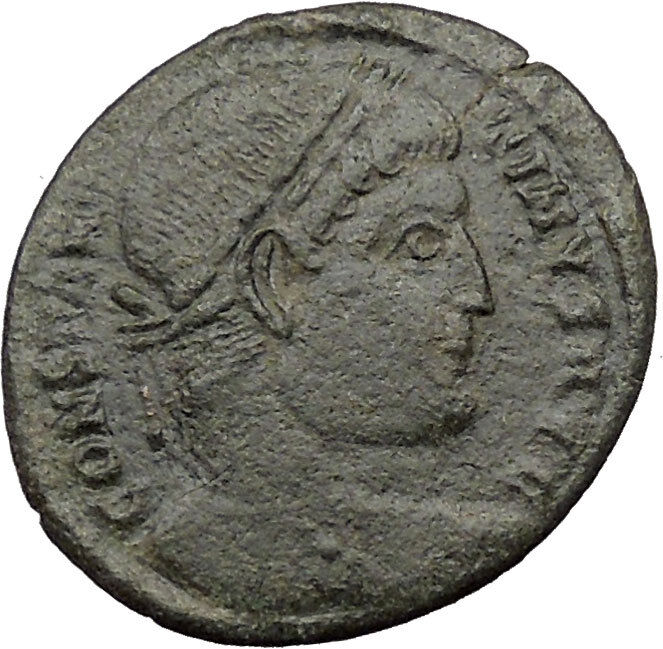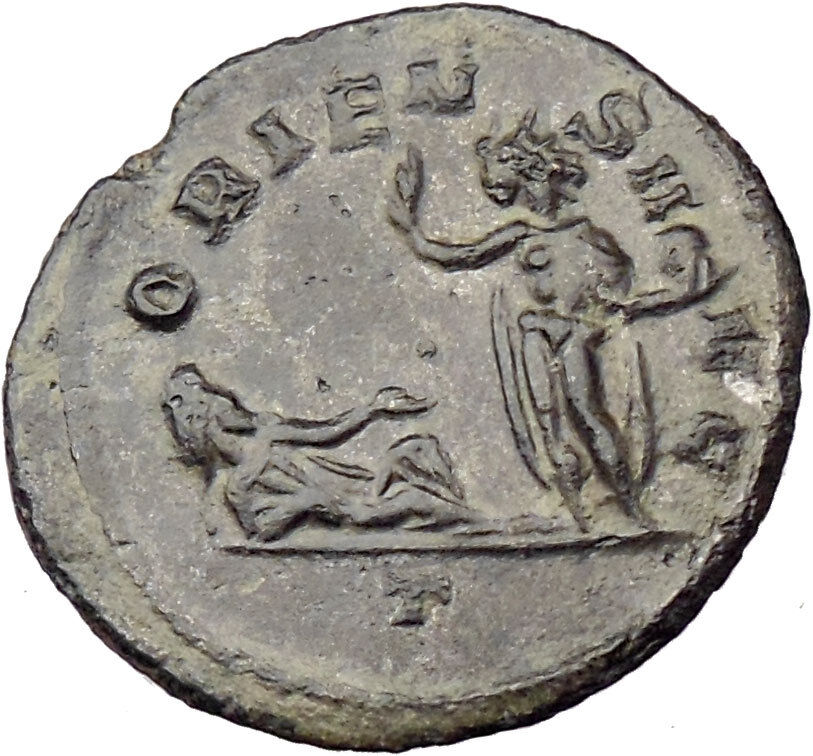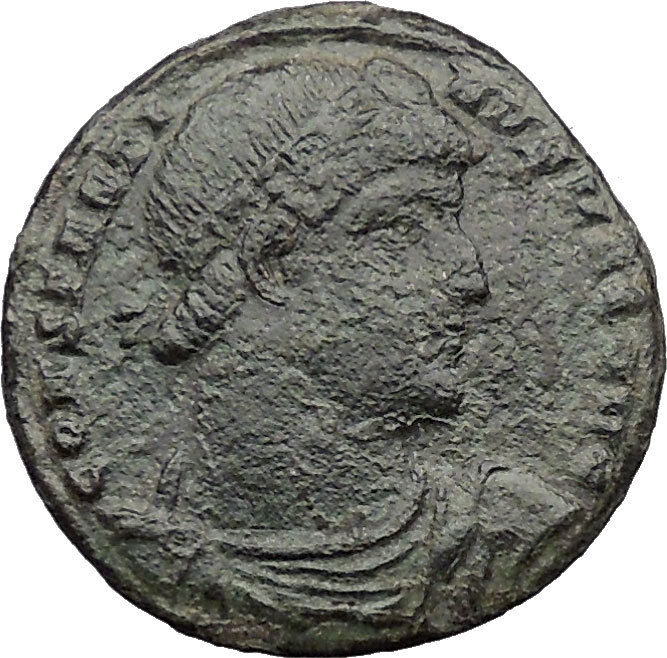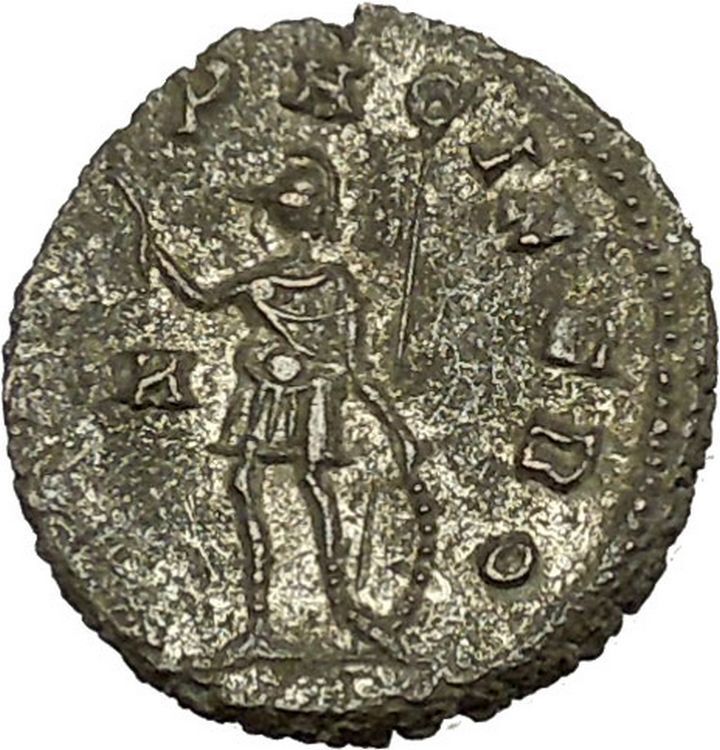|
Maximian – Roman Emperor: 286-305, 307-308 & 310 A.D.
Divus Maximian Posthumous Deification Issue, Struck under Constantine I, the Great
Billon Nummus or 1/2 Follis or 1-1/2 Scripula 15mm (1.83 grams)
Rome mint, 1st officina, struck circa 317-318 A.D.
Reference: RIC 120
Certification: NGC Ancients Ch AU Strike: 4/5 Surface: 3/5 4625013-001
DIVO MAXIMIANO SEN FORT IMP, laureate, veiled head of Maximian right.
MEMORIAE AETERNAE, lion advancing right, tail low, club in upper middle field; RP in exergue.
The primary reason for Constantine issuing these coins probably is political propaganda: Constantine tried to legitimize and consolidate his power by turning to his distinguished family tree of famous imperial relatives.
First, in this period of time, the real basis for imperial power was the support of as many legions as possible. No one could become (and stay) emperor solely based on his ancestry, no matter how many distinguished forebears he could boast of.
On the other side, the Roman legions did value the concept of hereditary imperial power. This was perhaps one of the major reasons why Diocletian’s Tetrarchic system (in which the next ‘Augustus’ was chosen based on his personal merits, rather than on his descent) failed. After the death of Constantius in 306 AD, his legions applauded his son Constantine as the new emperor, circumventing the rightful successor, Severus. In other words, Constantine did not require an extensive line of famous forefathers, dressed in purple, to ‘legitimize’ his imperial power. He had his legions to serve that purpose. But it certainly did not hurt his position to stress his descent from ‘the best emperors’ the Empire had known, emperors who became divinities also. Certainly this would not have fallen on deaf ears as far as the legions were concerned.
Constantine, apart from being a ruthless politician, was very aware of the divine world, and more specifically, of divine wrath. The issue can also be seen in this perspective. ‘To honor thy father and thy mother’ was one of the commandments of the Christian God, and the coins were issued after Constantine’s conversion to Christianity. Moreover, this idea of respecting and honoring one’s parents was also one of the most important virtues of the Romans. It was called ‘pietas’ and the issue of commemorative coins can be seen as a ‘pious’ act (as to this the Historia Augusta relates that Antoninus Pius got his surname because he had deified his ‘father’, the emperor Hadrian).
You are bidding on the exact item pictured, provided with a Certificate of Authenticity and Lifetime Guarantee of Authenticity.
Maximian – Roman Emperor 286 – circa 310 A.D.
Caesar: 285-286 A.D. (under Diocletian)
Augustus, 1st reign: 286-305 A.D. (with Diocletian)
2nd reign: 307-308 A.D. (with Maxentius and Constantine I the Great)
3rd reign: circa 310 A.D. (Independent)
| Son-in-law of Diocletian | Father of Maxentius and Fausta | Step-father of Theodora | Grandfather of Romulus |
.jpg/220px-MSR_-_Tête_de_l'empreur_Maximien_Hercule_-_Inv_34_b_(cropped).jpg) Maximian (Latin: Marcus Aurelius Valerius Maximianus Herculius Augustus; c. 250 – c. July 310) was Roman Emperor from 286 to 305. He was Caesar from 285 to 286, then Augustus from 286 to 305. He shared the latter title with his co-emperor and superior, Diocletian, whose political brain complemented Maximian’s military brawn. Maximian established his residence at Trier but spent most of his time on campaign. In late 285, he suppressed rebels in Gaul known as the Bagaudae. From 285 to 288, he fought against Germanic tribes along the Rhine frontier. Together with Diocletian, he launched a scorched earth campaign deep into Alamannic territory in 288, temporarily relieving the Rhine provinces from the threat of Germanic invasion. Maximian (Latin: Marcus Aurelius Valerius Maximianus Herculius Augustus; c. 250 – c. July 310) was Roman Emperor from 286 to 305. He was Caesar from 285 to 286, then Augustus from 286 to 305. He shared the latter title with his co-emperor and superior, Diocletian, whose political brain complemented Maximian’s military brawn. Maximian established his residence at Trier but spent most of his time on campaign. In late 285, he suppressed rebels in Gaul known as the Bagaudae. From 285 to 288, he fought against Germanic tribes along the Rhine frontier. Together with Diocletian, he launched a scorched earth campaign deep into Alamannic territory in 288, temporarily relieving the Rhine provinces from the threat of Germanic invasion.
The man he appointed to police the Channel shores, Carausius, rebelled in 286, causing the secession of Britain and northwestern Gaul. Maximian failed to oust Carausius, and his invasion fleet was destroyed by storms in 289 or 290. Maximian’s subordinate, Constantius, campaigned against Carausius’ successor, Allectus, while Maximian held the Rhine frontier. The rebel leader was ousted in 296, and Maximian moved south to combat piracy near Hispania and Berber incursions in Mauretania. When these campaigns concluded in 298, he departed for Italy, where he lived in comfort until 305. At Diocletian’s behest, Maximian abdicated on May 1, 305, gave the Augustan office to Constantius, and retired to southern Italy.
In late 306, Maximian took the title of Augustus again and aided his son Maxentius’ rebellion in Italy. In April 307, he attempted to depose his son, but failed and fled to the court of Constantius’ successor, Constantine (who was both Maximian’s step-grandson and also his son-in-law), in Trier. At the Council of Carnuntum in November 308, Diocletian and his successor, Galerius, forced Maximian to renounce his imperial claim again. In early 310, Maximian attempted to seize Constantine’s title while the emperor was on campaign on the Rhine. Few supported him, and he was captured by Constantine in Marseille. Maximian killed himself in mid-310 on Constantine’s orders. During Constantine’s war with Maxentius, Maximian’s image was purged from all public places. However, after Constantine ousted and killed Maxentius, Maximian’s image was rehabilitated, and he was deified.
At Mediolanum (Milan, Italy) in July 285, Diocletian proclaimed Maximian as his co-ruler, or Caesar. The reasons for this decision are complex. With conflict in every province of the Empire, from Gaul to Syria, from Egypt to the lower Danube, Diocletian needed a lieutenant to manage his heavy workload. Historian Stephen Williams suggests that Diocletian considered himself a mediocre general and needed a man like Maximian to do most of his fighting.
Next, Diocletian was vulnerable in that he had no sons, just a daughter, Valeria, who could never succeed him. He was forced therefore to seek a co-ruler from outside his family and that co-ruler had to be someone he trusted. (The historian William Seston has argued that Diocletian, like heirless emperors before him, adopted Maximian as his filius Augusti (“Augustan son”) upon his appointment to the office. Some agree, but the historian Frank Kolb has stated that arguments for the adoption are based on misreadings of the papyrological evidence. Maximian did take Diocletian’s nomen (family name) Valerius, however.)
Finally, Diocletian knew that single rule was dangerous and that precedent existed for dual rulership. Despite their military prowess, both sole-emperors Aurelian and Probus had been easily removed from power. In contrast, just a few years earlier, the emperor Carus and his sons had ruled jointly, albeit not for long. Even the first emperor, Augustus, (r. 27 BC-AD 19), had shared power with his colleagues and more formal offices of co-emperor had existed from Marcus Aurelius (r. 161-180) on.
The dual system evidently worked well. About 287, the two rulers’ relationship was re-defined in religious terms, with Diocletian assuming the title Iovius and Maximian Herculius. The titles were pregnant with symbolism: Diocletian-Jove had the dominant role of planning and commanding; Maximian-Hercules the heroic role of completing assigned tasks. Yet despite the symbolism, the emperors were not “gods” in the Imperial cult (although they may have been hailed as such in Imperial panegyrics). Instead, they were the gods’ instruments, imposing the gods’ will on earth. Once the rituals were over, Maximian assumed control of the government of the West and was dispatched to Gaul to fight the rebels known as Bagaudae while Diocletian returned to the East.
Spurred by the crisis with Carausius, on April 1, 286, Maximian took the title of Augustus. This gave him the same status as Carausius – so the clash was between two Augusti, rather than between an Augustus and a Caesar – and, in Imperial propaganda, Maximian was proclaimed Diocletian’s brother, his equal in authority and prestige. Diocletian could not have been present at Maximian’s appointment, causing Seeck to suggest that Maximian usurped the title and was only later recognized by Diocletian in hopes of avoiding civil war. This suggestion has not won much support, and the historian William Leadbetter has recently refuted it. Despite the physical distance between the emperors, Diocletian trusted Maximian enough to invest him with imperial powers, and Maximian still respected Diocletian enough to act in accordance with his will.
In theory, the Roman Empire was not divided by the dual imperium. Though divisions did take place – each emperor had his own court, army, and official residences – these were matters of practicality, not substance. Imperial propaganda from 287 on insists on a singular and indivisible Rome, a patrimonium indivisum. As the panegyrist of 289 declares to Maximian: “So it is that this great empire is a communal possession for both of you, without any discord, nor would we endure there to be any dispute between you, but plainly you hold the state in equal measure as once those two Heracleidae, the Spartan Kings, had done.” Legal rulings were given and imperial celebrations took place in both emperors’ names, and the same coins were issued in both parts of the empire. Diocletian sometimes issued commands to Maximian’s province of Africa; Maximian could presumably have done the same for Diocletian’s territory.
Constantius, Gennobaudes, and resettlement
In early 288, Maximian appointed his praetorian prefect Constantius Chlorus, husband of Maximian’s daughter Theodora, to lead a campaign against Carausius’ Frankish allies. These Franks controlled the Rhine estuaries, thwarting sea-attacks against Carausius. Constantius moved north through their territory, wreaking havoc, and reaching the North Sea. The Franks sued for peace and in the subsequent settlement Maximian reinstated the deposed Frankish king Gennobaudes. Gennobaudes became Maximian’s vassal and, with lesser Frankish chiefs in turn swearing loyalty to Gennobaudes, Roman regional dominance was assured.
Maximian allowed a settlement of Frisii, Salian Franks, Chamavi and other tribes along a strip of Roman territory, either between the Rhine and Waal rivers from Noviomagus (Nijmegen, Netherlands) to Traiectum, (Utrecht, Netherlands) or near Trier. These tribes were allowed to settle on the condition that they acknowledged Roman dominance. Their presence provided a ready pool of manpower and prevented the settlement of other Frankish tribes, giving Maximian a buffer along the northern Rhine and reducing his need to garrison the region.
After the death of Constantius on July 25, 306, Constantine assumed the title of Augustus. This displeased Galerius, who instead offered Constantine the title of Caesar, which Constantine accepted. The title of Augustus then went to Severus. Maxentius was jealous of Constantine’s power, and on October 28, 306, he persuaded a cohort of imperial guardsmen to declare him as Augustus. Uncomfortable with sole leadership, Maxentius sent a set of imperial robes to Maximian and saluted him as “Augustus for the second time”, offering him theoretic equal rule but less actual power and a lower rank.
Galerius refused to recognize Maxentius and sent Severus with an army to Rome to depose him. As many of Severus’ soldiers had served under Maximian, and had taken Maxentius’ bribes, most of the army defected to Maxentius. Severus fled to Ravenna, which Maximian besieged. The city was strongly fortified so Maximian offered terms, which Severus accepted. Maximian then seized Severus and took him under guard to a public villa in southern Rome, where he was kept as a hostage. In late 307, Galerius led a second force against Maxentius but he again failed to take Rome, and retreated north with his army mostly intact.
In 310, Maximian rebelled against Constantine while the Emperor was on campaign against the Franks. Maximian had been sent south to Arles with part of Constantine’s army to defend against attacks by Maxentius in southern Gaul. In Arles, Maximian announced that Constantine was dead and took up the imperial purple. Although Maximian offered bribes to all who would support him, most of Constantine’s army remained loyal, and Maximian was compelled to leave the city. Constantine soon heard of the rebellion, abandoned his campaign against the Franks, and moved quickly to southern Gaul, where he confronted the fleeing Maximian at Massilia (Marseille). The town was better able to withstand a long siege than Arles, but it made little difference as loyal citizens opened the rear gates to Constantine. Maximian was captured, reproved for his crimes, and stripped of his title for the third and last time. Constantine granted Maximian some clemency but strongly encouraged his suicide. In July 310, Maximian hanged himself.
Despite the earlier rupture in relations, after Maximian’s suicide Maxentius presented himself as his father’s devoted son. He minted coins bearing his father’s deified image and proclaimed his desire to avenge his death.
Constantine initially presented the suicide as an unfortunate family tragedy. By 311, however, he was spreading another version. According to this, after Constantine had pardoned him, Maximian planned to murder Constantine in his sleep. Fausta learned of the plot and warned Constantine, who put a eunuch in his own place in bed. Maximian was apprehended when he killed the eunuch and was offered suicide, which he accepted. In addition to the propaganda, Constantine instituted a damnatio memoriae on Maximian, destroying all inscriptions referring to him and eliminating any public work bearing his image.
Constantine defeated Maxentius at the Battle of the Milvian Bridge on October 28, 312. Maxentius died, and Italy came under Constantine’s rule. Eutropia swore on oath that Maxentius was not Maximian’s son, and Maximian’s memory was rehabilitated. His apotheosis under Maxentius was declared null and void, and he was re-consecrated as a god, probably in 317. He began appearing on Constantine’s coinage as divus, or divine, by 318, together with the deified Constantius and Claudius Gothicus. The three were hailed as Constantine’s forebears. They were called “the best of emperors”. Through his daughters Fausta and Flavia, Maximian was grandfather or great-grandfather to every reigning emperor from 337 to 363.
|








.jpg/220px-MSR_-_Tête_de_l'empreur_Maximien_Hercule_-_Inv_34_b_(cropped).jpg) Maximian (Latin: Marcus Aurelius Valerius Maximianus Herculius Augustus; c. 250 – c. July 310) was Roman Emperor from 286 to 305. He was Caesar from 285 to 286, then Augustus from 286 to 305. He shared the latter title with his co-emperor and superior, Diocletian, whose political brain complemented Maximian’s military brawn. Maximian established his residence at Trier but spent most of his time on campaign. In late 285, he suppressed rebels in Gaul known as the Bagaudae. From 285 to 288, he fought against Germanic tribes along the Rhine frontier. Together with Diocletian, he launched a scorched earth campaign deep into Alamannic territory in 288, temporarily relieving the Rhine provinces from the threat of Germanic invasion.
Maximian (Latin: Marcus Aurelius Valerius Maximianus Herculius Augustus; c. 250 – c. July 310) was Roman Emperor from 286 to 305. He was Caesar from 285 to 286, then Augustus from 286 to 305. He shared the latter title with his co-emperor and superior, Diocletian, whose political brain complemented Maximian’s military brawn. Maximian established his residence at Trier but spent most of his time on campaign. In late 285, he suppressed rebels in Gaul known as the Bagaudae. From 285 to 288, he fought against Germanic tribes along the Rhine frontier. Together with Diocletian, he launched a scorched earth campaign deep into Alamannic territory in 288, temporarily relieving the Rhine provinces from the threat of Germanic invasion.




